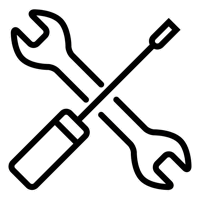Radiodetection SuperCAT4+ Underground Telecoms and Cable Locator
SKU code: SuperCAT4
Part of the Radiodetection SuperCAT range, the SuperCAT4+ is a multi-frequency locator, with transmitter options, specifically designed for high-impedance telecom lines and low power power cables. Featuring Dynamic Overload Protection, StrikeAlert and TruDepth technology, the SuperCAT4+ allows the user to accurately detect services in a safe and efficient manner.
The Radiodetection SuperCAT4+ can utilise a comprehensive set of active frequencies, in order to detect and trace different cable types, in variety of environmental conditions. Higher frequencies, such as 65kHz and 131kHz, can be used to find well insulated utilities such as twisted-pair telecom cables or insulated pipe joints. For long range locating of lower resistance cables such as power lines, lower frequency options are available.
Matched in a kit with one of Radiodetection's T1 transmitter range, the SuperCAT4+ offers a variety of active line frequencies. This includes a standard active locating frequencies of 8kHz and 33kHz for general locating, as well as higher frequency lines of 65kHz and 131kHz which are specified for locating telecommunication cables.
The SuperCAT4+ can be operated using a simple mode selection, which can be chosen based on the signal type being located. The two main modes on the SuperCAT4+ are the power mode and the radio mode. As the name suggest, power mode is utilised to detect electromagnetic fields generated by loaded power cables. Power mode also features StrikeAlert, which warns the user of shallow buried utilities. Radio mode, on the other hand, is applied to detect long range radio signals, which can be radiated along dead or non-current carrying services such as buried metallic cables and pipes.
As well as StrikeAlert, the SuperCAT4+ comes with a range of features, designed for safe work practices. One such feature is Dynamic Overload Protection filters, which enables the user to filter out high levels of electrical interference, as found around substations and near high-voltage transmission cables. TruDepth technology is also present on this model, which only indicates depth when the locator is oriented correctly above the target cable, pipe or sonde, and thus, aids in providing the most accurate depth reading. Real Sound is another feature of this particular model, in which the audio signals emitted by the SuperCAT4+ are derived from the signals detected. Radio and Power Mode signals can be easily distinguished from each other and from background noise, helping to identify target utilities and differentiating between co-located utilities.
Built for on-site use, the SuperCAT4+ is designed with lightweight, ABS casing and is rated to IP54 for all-weather operation. The SuperCAT4+ features a high-contrast display with auto-backlight and bargraph, allowing the user to zone in on the buried service. In addition, the SuperCAT4+ is battery powered, has a loud speaker for audible warnings and is capable of sensitivity control.
The Radiodetection SuperCAT4+ can be paired with an array of accessories, which are available for applying signals safely and effectively to pipes and cables, including live cables. Flexrods can be used to push a wide range of sondes up to 150m. For non-conductive pipes or conduits, the T1 transmitter can be connected to a FlexiTrace, which enables continuous locating and tracing of non-metallic ducts or pipes, for up to 80m. Signal clamps can also be used to apply a transmitter signal to a specific cable or pipe where direct connection is not possible and live plug and cable connectors can be used to energize difficult to locate cables such as street distribution or lighting cables.
Key Features:
- Multiple frequency selection for power and telecom cables.
- Power Mode for live, underground cables.
- Radio Mode for dead services such as metallic pipes.
- Strike Alert - warning of live, shallow services.
- TruDepth - accurate depth measurement.
- Dynamic Overload Protection for filtering interference.
- Real Sound - audio signals are derived from the signals detected.
- High contrast display with backlight and bargraph.
- Battery operated receiver and transmitter.
- Sensitivity control.
More From This Category














